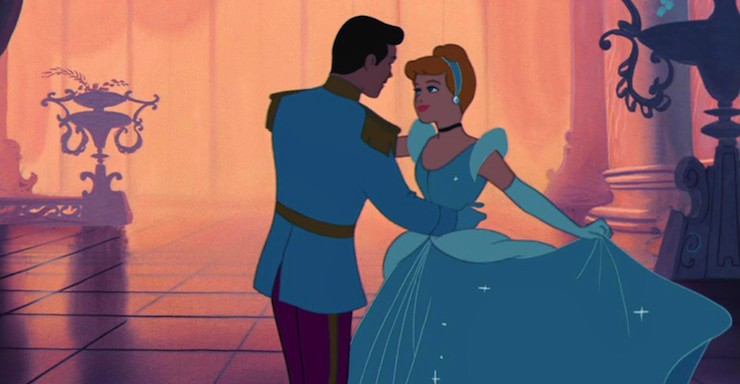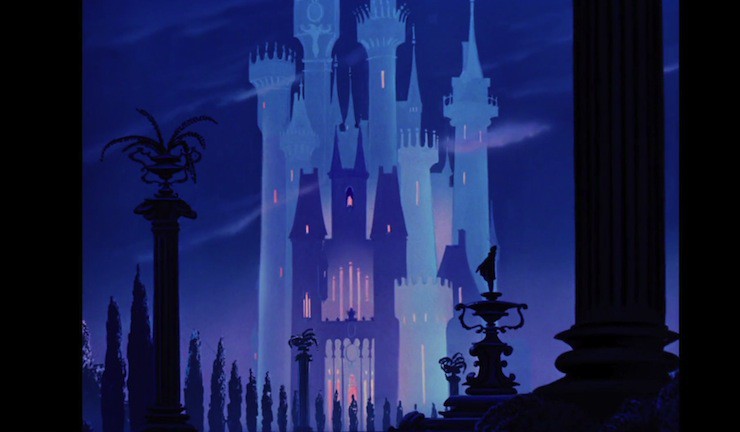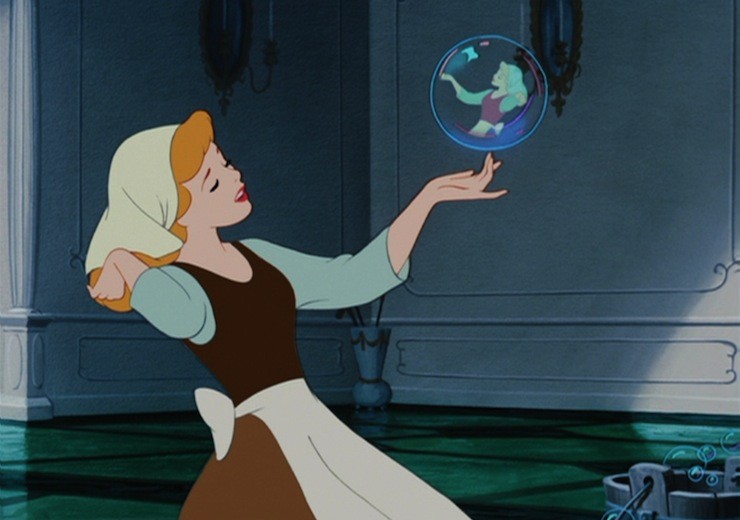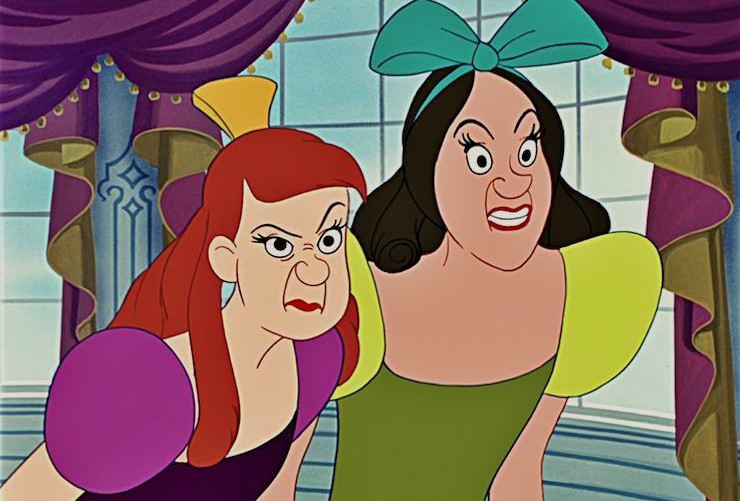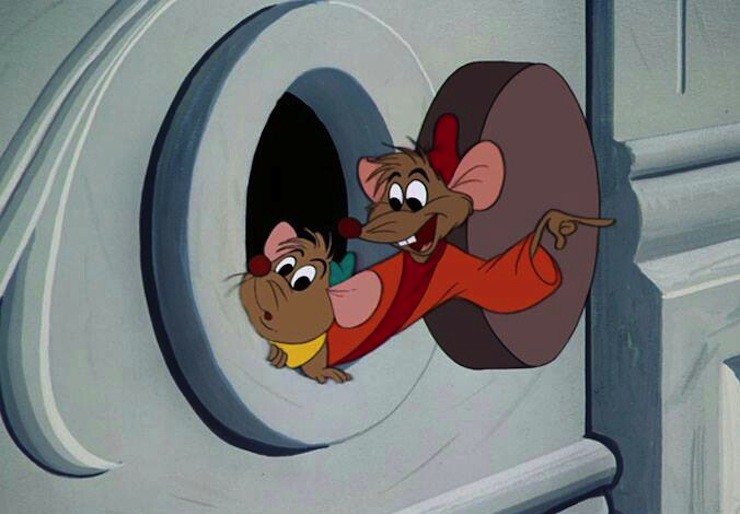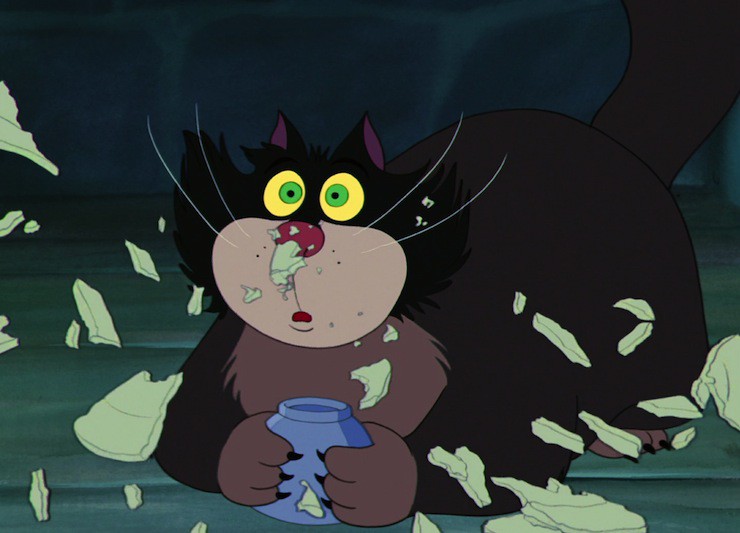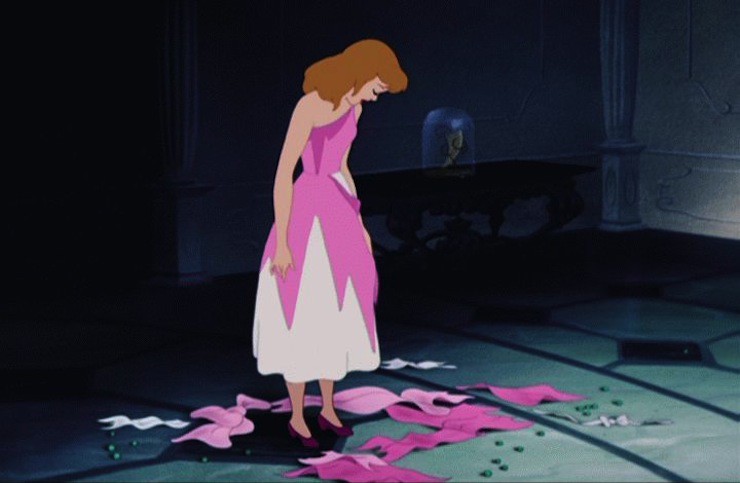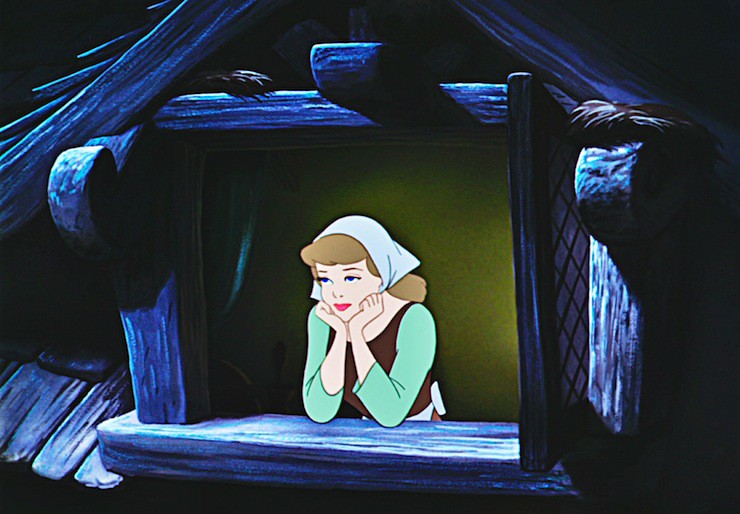“A pretty plot for fairy tales, sire, but in real life, oh, no. No, it was foredoomed to failure.”
–The Grand Duke, about to be proved wrong in Cinderella (1951)
War training films, anthology movies, and plenty of bank loans had just barely allowed Walt Disney to scrape through the 1940s intact. With finances finally a little less shaky, Disney set his animators to work on two films he’d been planning to do since before the war: Cinderella and Alice in Wonderland. Not that he could quite afford to return to the lush animation of Pinocchio and Fantasia, or even the simpler animation of Dumbo, something even the most superficial look at Cinderella shows, but he could at least create full length films again. Disney’s top nine animators were all assigned to Cinderella and asked to help out with Alice, with the two films competing to see which would be the first to be Disney’s first full length animated film release since Bambi, signaling a return to the grand days of Disney animation.
Fortunately for Disney history, the winner turned out to be Cinderella (1950).
Not, I must say, because of the animation, one place where Disney sharply cut costs. Initial scenes that could have been animated were “storybooked” insteadvthat is, shown as single illustrations from storybooks, complete with voiceover. The lush, often multi level backgrounds of previous films were replaced by simple, static illustrations. The outside of Cinderella’s castle is remarkably plain. Even the lines to indicate stones or bricks—present in Snow White—are missing. Most scenes are staged so that only one or two characters need to be moving at any given moment, in direct contrast to Pinocchio, which often had up to 40 different moving animated parts. To further simplify matters, in many scenes, the camera doesn’t move, allowing the background to remain completely still. In a few scenes, only one or two elements of the entire shot move at all, with everything else completely still: note, for example, one of the early scenes with the Evil Stepmother, Lady Tremaine, where the camera lingers on her, and only her eyes move. Slightly.
Animators used other small tricks to save money: Cinderella’s pumpkin coach sails over the ground partly so that the animators would not have to draw spinning wheels, for instance. Cinderella and her prince almost immediately head out to the garden so that only two dancing characters had to be animated. The prince loses track of Cinderella so that only one person needs to follow Cinderella down the stairs. Two of the mice were made to look identical so that they could, if necessary, be copied (and in some cases were.)
It’s not that the film is lacking in lovely animated moments—Cinderella’s transformation scene is justly celebrated, for instance, and her dance with the prince happens in a lovely soft blue grey background, providing some exquisite moments. But overall, the film is less, well, animated than many of the other Disney movies—including the considerably cut for budget reasons The Adventures of Ichabod and Mr. Toad. And the result, odd for a film in theory focused on a grand court ball and what happened afterwards, is a film that visually often feels rather plain. On the other hand, this did allow the film to linger on some of its characters—notably Lady Tremaine—to its definite benefit.
Animation costs weren’t the only issue: Disney also had to figure out how to stretch what is, after all, a very short story. They began by somewhat extending the palace story—giving the king a reason to hold this ball for his son, as well as a sidekick for the king to speak to, allowing for a couple of comedic moments here and there. Both the King and the Grand Duke are voiced by the same actor, and both are a lot more interesting than the prince, which is not saying much—he’s even more boring than the prince in Snow White, not a sentence I thought I would be typing.
Part of the problem is that the prince is a complete non entity. What we know about him: he hasn’t been interested in love before this movie and he can dance, sing, look at a water from a bridge, and is completely unable to chase a woman through a palace without running into other women. That ends his role in the film. He doesn’t even find the glass slipper—the Grand Duke is the one to pick that shoe up from the stairs, and the one to hunt down Cinderella with that slipper. This is one useless, boring prince, is what I’m saying, and frankly, I’d be happier pairing up this Cinderella with someone more interesting, like the Grand Duke or one of the mice. But moving on.
Cinderella, fortunately, has more of a personality, though admittedly she could hardly have less. But her story starts with a delightfully humanizing touch: she hates getting up in the mornings, and is more than happy to pull a pillow over her head to shut out the overly cheerful bird noises. I’m with you, Cinderella, I’m with you. (Or she’s also trying to shut out the somewhat disturbing site of a little bluebird wearing a headscarf—the bluejays around here are already happy enough to steal things without giving them any ideas about needing to wear headwear, Disney.)
Later, Cinderella proves to have a touch of a temper—she’s learned to control it, but the anger is there, and it’s good to see. She’s not above complaining—if only quietly, and mostly to the mice—about her position in the household. And, in a nice scene, she stands up for her right to attend the ball, given that all eligible maidens are invited—and her later attempt to tell herself that she doesn’t really want to go to the ball because it will be boring is not just rather touching, but also provides a nice bit of insight on the survival skills she’s used to keep herself from completely collapsing beneath the abuse of her stepmother and stepsisters.
And her failure to recognize that she has caught the attention of the prince—she assures the mice that she’s certain the prince couldn’t have been nearly as handsome—if not exactly boding well for her ability to recognize court dignitaries in the future, or for her attention to current events, at least provides evidence that she hasn’t fallen in love with the prince for his money and rank. Or that, as said, he’s really not much of a prince. Against this, we can say that she does seem to have a taste for bland men with superficially good looks, but we can’t have everything. To be fair, it’s possible that continual abuse from three people with more interesting if awful personalities has given her a new appreciation for bland.
Oh, and I use the word “abuse” deliberately. Not just because the script does, but because in many ways the stepsisters here are far worse than they are in the Perrault version, and even arguably in the Grimm version—the one that ends with their eyes getting pecked out. In the Perrault version, yes, they’ve turned Cinderella into a fairly filthy servant, and they make fun of her looks and the dirt on her face, but they also make it clear that they appreciate her taste in clothing and hairdressing, and do occasionally speak to her as a human being. And in the end, they apologize profusely. I’m not quite willing to buy Cinderella’s willingness to marry them off to noblemen, but there’s some sort of buildup to that moment.
Here, the stepsisters violently attack Cinderella—physically. They do so as the stepmother coolly watches, having already played out her emotional torture on Cinderella earlier, and not needing to do more.
Incidentally, Cinderella is remarkably clean and sparkling in this version, thanks to some helpful birds able to create a quick shower.
But family abuse, superficial royal storylines, showers provided by helpful birds, and a bland love interest could only take up so much screentime. To fill out the story, Disney needed more—and for more, they turned to something that had already been a success: cute little animals. In this case, mice. Well, mostly. Those birds, one dog, a horse, and Lucifer the cat skulk around as well. In a nice nod to the Grimm version, the birds provide practical assistance in the morning and with that dress. The dog has a last minute moment of heroism, and the horse is—well, the horse is there. But really, this is mostly a tale of mice.
As a result, most of your tolerance for Cinderella will depend upon your tolerance for adorable little mice, and more specifically, adorable little mice with very squeaky voices who sing a lot and really ought to be working out more so that they don’t have to struggle so much just to bring one single key up—ok, well, that is a lot of stairs. But still, mice.
The rest of you are going to be cheering on Lucifer, the evil cat.
I certainly was at times. Before everyone judges me, (a) those mice are very squeaky, and (b) Lucifer does has his sympathetic moments—it’s hard not to feel for a cat who has to listen to what Druzilla and Anastasia call singing on the same day where he’s been scheduled for a bath, to the point where I couldn’t even blame the poor cat for leaving muddy footprints everywhere after this. And in one scene, to give Lucifer all due credit, he is trying to stop one mouse from pulling buttons from a dress and ruining it, and stop the mice from stealing sashes and beads. Given the later results of this theft—the previously mentioned physical attack on Cinderella—it might have gone better for everyone if Lucifer had succeeded. If only people had understood him. And, credit where credit is due: he does provide the only “scary” moment of a film that has otherwise been rather tame.
Besides, Lucifer, at least in looks, was based on the fat, beloved and rather indulged cat of animator Ward Kimball—a cat that, as far as I know, was never accused of conducting psychological warfare on cute little mice or of leaving pawprints on freshly cleaned floors. Would Ward Kimball have allowed this respectable, dignified cat to be the basis for a truly evil villain? I think not.
Anyway. Disney’s other changes were more fundamental than cute little mice and evil cats. In the Perrault version, the Fairy Godmother provides assistance in the form of rich clothing, a carriage, and servants, but from there on, Cinderella has to fend for herself. She triumphs thanks to her social skills in dancing and conversation. In the Grimm version, Ashputtel summons her own magical assistance—and her animals help her complete the stepmother’s tasks. In the film, the animals help Cinderella wake up and get dressed, but she does her other chores on her own. And after her transformation, she becomes a far more passive figure. Instead of charming everyone at the ball, she’s led away from it (to save on animation costs, granted, but she doesn’t protest.) Instead of running from the ball and saving herself, she’s driven away from the ball by the transformed animals, who help her hide in the bushes.
And in the film’s final sequences Cinderella is trapped in her tower, unable to escape—in complete contrast to the Cinderella of Perrault, who simply steps forward and asks to be allowed to try on the slipper, or the Ashputtel of the Grimms, whose two pigeons inform the prince that something is going on. (It helps that this prince, unlike the Disney prince, is able to ask some pointed questions.) Ashputtel can summon animal assistance. Here, the animals just show up. Yes, this in part because she’s fed them and talked to them, but that ends her active role. This is a girl in need of rescue multiple times: by her fairy godmother, by her prince, and by two struggling little mice—in major contrast to Perrault’s Cinderella, who just needed new clothes and footwear to set her world on fire, or Grimm’s Ashputtel, who could summon birds for help. This Cinderella may be considerably brighter than Snow White (well, not may—she definitely is more aware, less naive, and not the sort who would take an apple from a questionable stranger) but despite that intelligence, she’s also more helpless.
The other changes from the source material are more subtle. Both Perrault and the Grimms set their stories in very real worlds. Perrault’s characters wore makeup from French salons and sported the latest hairstyles. The Grimms published their tales in a post-Napoleonic world where kings and princes could and did still wield considerable power, and could force immediate obedience, where the advantages of marrying a prince outweighed the loss of a toe, where a prince did need to ask pointed questions in order to stay alive.
The 1950 Cinderella, in contrast, is set in some unspecified, far off past: the 17th century, perhaps, or the 18th. It’s impossible to tell from the clothing. No one sheds blood, and the king and prince are both oddly powerless. The king cannot force his son to wed—at most, he’s hoping the prince will meet someone at the ball. The prince is almost irrelevant: he doesn’t plan or cause the ball; he doesn’t start the search for the wearer of the shoe. Even Snow White’s prince, who is also barely in her film, at least starts the plot with his arrival, and saves Snow White with his kiss. This prince doesn’t do any of the saving. That’s all on the fairy godmother, those mice, the dog, and the Grand Duke. And Cinderella, unlike Snow White, isn’t waiting for a prince. She just wants to fall in love and find a home.
Because despite the ball, the shoes, the song out in in the garden under the moonlight, Cinderella is not a film that believes in princes. It’s a film created after many aristocracies had fallen, created after a king had abdicated a throne in order to marry a commoner. (Snow White was released after the Duke of Windsor’s startling announcement, but developed and storyboarded before it.) It is not a film that needs to convince us of the goodness and power of princes, and so it does neither, giving us a prince who is almost defeated by Lady Tremaine.
Cinderella is not, like the Perrault tale, a triumphant story of the glories of the French court and the ease of social climbing, or, as in the Grimm story, a triumphant story of piety and magic, of princes clever enough to listen to birds and see through lies and seek out their own brides. It’s instead a story that suggests that these days, at least, you don’t need social or magical skills to marry a prince. You merely need to be good, work hard, and dream.
And just maybe get some help from some mice.
Arguably, Cinderella’s release marked the real start of the Walt Disney entertainment monolith. Walt Disney used the profits from the wildly successful film to fund additional live action and animated films, take a look at television and—most notably—begin to build a small place in California called Disneyland. In later decades, Cinderella’s Castle became the center of Disney World’s Magic Kingdom, featuring a (rather overpriced) restaurant on its second floor that allowed guests to dine more or less like Cinderella. Much later, it also featured a hotel room suite that has been called the most exclusive hotel room in the world (by, I must note, Disney subsidiary ABC.) Cinderella herself later formed a center part of the popular Disney Princess line.
But this popularity, and Disney’s growth, did not happen in a straight uphill climb. Which is to say, Alice in Wonderland, up next.
Mari Ness lives in central Florida.










